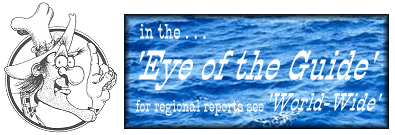SALTWATER CHRONICLES FLY FISHING ADVENTURES IN SALTWATER (part 11)
| Sysadmin Note |
|---|
| Part 10 can be found here |
Snook:
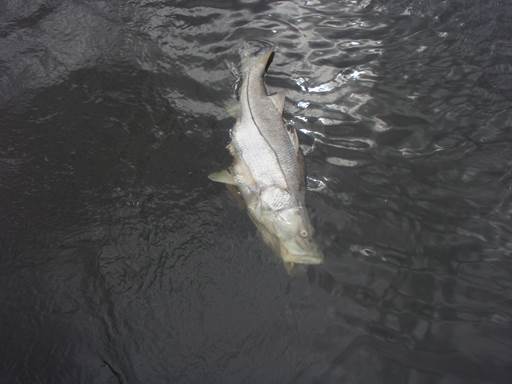
Common Snook [Centropomus undecimalis], this specie is native to the coastal waters of Florida (and many other places) they can reach 4.6 feet in length and weigh 53 plus pounds and may live up to twenty years. Furthermore their spectacular aerial displays endear them to the angler and this is one of the very few saltwater species that you can "Lip" without endangering your fingers!
Depending on the exact location the snook spawning occurs from April to October in near-shore waters, inlet passes and along the beaches close to the inlets. The young snook move to the lagoons, estuaries, brackish and saltwater rivers. The young snook prefer sloping banks with over hanging vegetation. The young snook feed on bay anchovy, pinfish, grass shrimp, mosquito fish, and insects whereas the adults primarily feed on menhaden, mllet, pinfish, anchovies, pigfish, shrimp and crabs. However they are very much opportunistic feeders which endear them to the anglers.
Snook are often found in shallow water but can be found in water up to 70 feet in depth and during the late spring and throughout the summer you can find snook in schools of twelve to forty or so cruising along the beaches looking for schools of baitfish.
Due to their willingness to take both subsurface and surface flies coupled with the excitement of the strike makes the snook one of the most sought after gamefish in Florida. Because of their legendary status as excellent table fare (meaning that they are very tasty) the seasons and limits of snook are closely monitored by the State of Florida.
In Florida there is no commercial snook fishing only recreational fishing is allowed, however before you gear up to put a couple of them on the table make sure that you check the regulations to ensure that the season is open and check your license to make sure that you have a snook stamp!
Snook in the Sebastian area are legendary and especially larger snook at night. Many of the expert bait and lure anglers I have spoken to claim that the snook in the Sebastian area are of the quantity and quality to make the area one of the best in the State of Florida.
Many years ago I witnessed the number of boats at the Inlet Pass during the height of snook season in the fall and was astonished and wondered how they all kept from running into each other or tangling lines with other anglers. But they all seem to fish with very few mishaps, however I will caution you that the Sebastian Inlet Pass is nothing to treat lightly, as the currents are strong and without acute observation you can find yourself in trouble. However, I avoid the crowds at the pass and fish along the lighted docks and shorelines of the Indian and St. Sebastian River or on the Grass Flat just inside the Inlet Pass. Furthermore these areas are easier for the fly angler to cover and are very productive. If you are out at night in a boat make sure that your running lights are in working order and that you have all the required safety equipment.
Now I know that you readers are like I am, a fly angler but I have found time and time again that by talking to the bait anglers, lure fishermen and bait shops operators that you can learn a tremendous amount about the fishing in a specific area. Then you can translate that information into fly fishing terms.
I have found over the years that the fly angler can learn much from the disciples of angling coupled with knowledge gleaned from books, other fly anglers, the Internet and personal observations. This has allowed me to quickly get the feel of an area and a particular specie.
Another bonus about learning about both the young and adult snook in the Sebastian Inlet area is, that regardless of how slow the general fishing might be that I can always slide up the mangrove covered shores of the St Sebastian River and always pick up a few smaller snook on poppers or small minnow imitations unless it is during the winter months and the water temperatures are to cool.
One important point to remember when targeting snook is that they are very water temperature sensitive. In cooler water temperatures slow down your retrieve speed as the snook become very lazy and sluggish in cooler waters. They prefer water temperatures of 68 to 78 degrees. During a cool winter there are very few snook caught from late December to early March, but remember this is all tied to water temperature therefore knowing the water temperature in the water you are fishing is critical during the winter months.
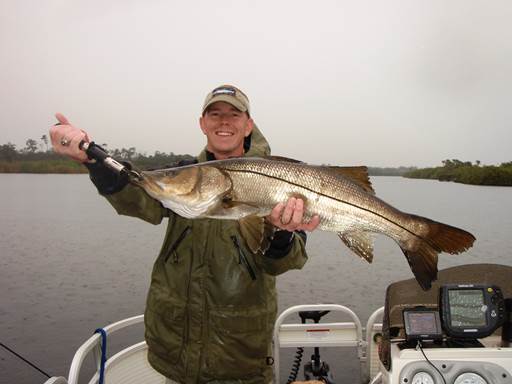
I have covered how some of the largest snook are taken at night but there is nothing wrong with fishing for snook during the daylight hours where you can enjoy the sights and sounds of the day. Snook are the perfect fly rod fish willing to freely move and feed at any time of the day or night. I have caught my largest snook during overcast days just prior to a major storm front moving into the area as is demonstrated by the photo of my son Ryan with a monster snook taken on January 1st at 10:30 A.M. That's not a bad way to start the fishing year, huh!
For those anglers who are unfamiliar with snook fishing with a fly but wish to get stated then I strongly recommend getting a copy of Norm Zeigler's Snook on A Fly published in 2007 by Stackpole Books. I consider this volume a must for the serious fly rod snook angler.
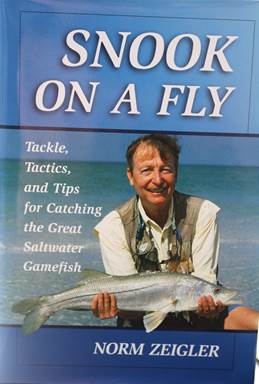
Snook on A Fly is an excellent guide for both the beginner and the advanced angler. The book explains the snook, how to fish from the beach, from boats, and flats, along with excellent fishing advice and tips on tactics and covering the tackle that Norm recommends. Also this volume contains excellent photographs which are so important to understanding the snook, flies and tactics.
I use an eight weight system when fishing for snook. Now I know that often I could successfully use a six weight system but every time I use a six weight while catching smaller snook or ladyfish I end up hooking a larger fish where I wished I was using a heavier rod. Now I will share a couple of my favorite snook flies with you.
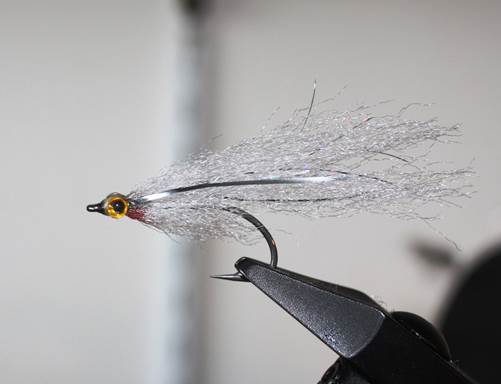
Little Silvery White Minnow
- Hook: Dai-Riki 930 Sizes: 2-8
- Thread: White 6/0
- Wing/Body: White EP Fibers with 8 strands of Silver Holographic Flash, topped with another Bunch of White EP Fibers, then place on either side a strip of wide Silver Flash-A-Bou
- Belly: White EP Fibers
- Gills: Red slash on the belly made with a Red Sharpie marker
- Eyes: 3-D Red with Black centers applied with epoxy

Black & Purple Snook Popper
- Hook: Mustad 34007 Sizes: 1/0-6
- Thread: White 6/0
- Popper: Black Foam Popper head with 3D Yellow Eyes with Black centers and are applied with epoxy, the style of popper head is left to the choice of the angler and what is to be accomplished with the popper
- Wing/Body: White EP Fibers with three or four strands of Silver Holographic flash on top followed by Purple EP Fibers
- Belly: White EP Fibers
Note: Once the imitation is complete, comb out and trim to desired shape

Salty Root Beer Shrimp
- Hook: Mustad 34007 Sizes: 1 to 8
- Thread: Hot red, 6/0
- Tails: Thin tapered point of clear plastic, several strands, pearl Krystal flash, then Pearl Krystal flash, then two strands of silver motion Mylar, slightly longer than the tail
- Antennae: Two strands of black Krystal flash 1½ times the length of the hook
- Eyes: Lead, painted red with black centers, tied on the bottom of the hook at the back of the hook
- Head: Dubbed Scintilla #58 Garden Hackle
- Shellback: Clear heavy plastic strips
- Rib: Dark fine Ultra thread
- Body: Root beer Holographic and Tri-lobal Hackle, wrapped tightly
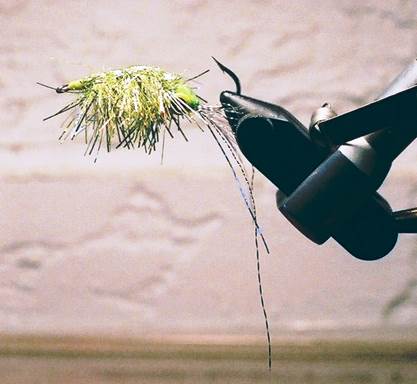
Salty Chartreuse/Green Shrimp
- Hook: Mustad 34007 or 34011 Sizes: 1 to 8
- Thread: Hot Chartreuse 6/0
- Tails: Clear Plastic Point
- Antennae: Several strands of Pearl Krystal Flash, two strands of silver motion Mylar, slightly longer than the pearl K-flash. Plus two strands of black Krystal flash which is one and one half times the length of the hook.
- Eyes: Lead, painted hot Chartreuse with a black center, tied at the rear of the hook on the bottom of the hook shank, so the imitation will ride hook point up.
- Head: Dubbed, Scintilla #57 bright lime
- Shellback: Clear heavy plastic strip
- Rib: Dark fine ultra-thread
- Body: Chartreuse Holographic and tri-lobal hackle 1-/4 wrapped tightly.
Enjoy & Good Fishin'
| Sysadmin Note |
|---|
| Part 12 can be found here |
